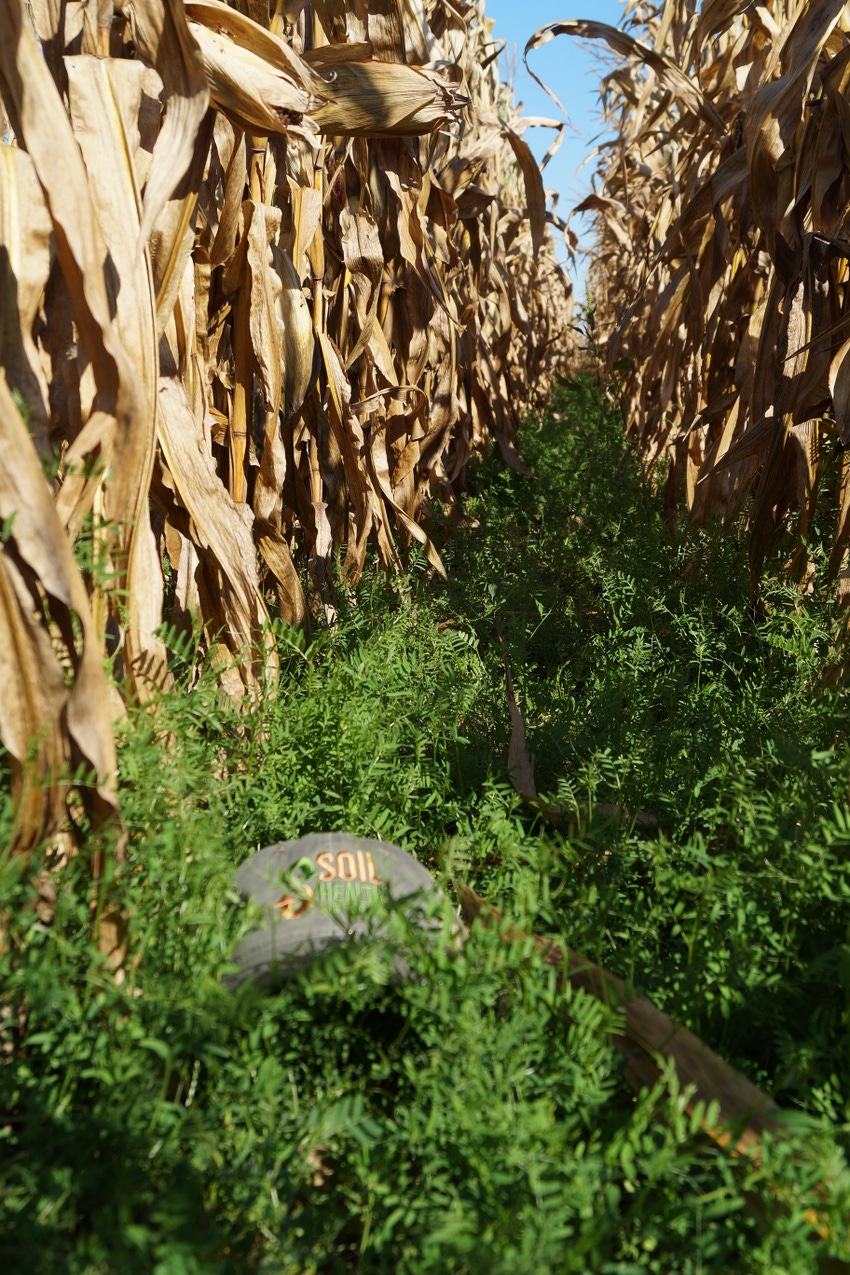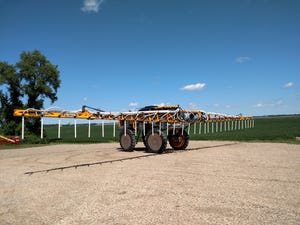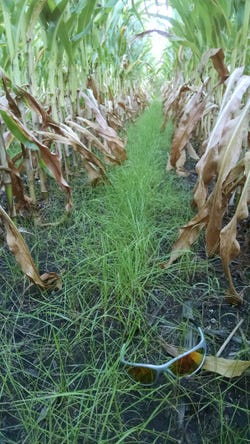October 4, 2016

Think Different
“After World War II we converted unused ammunition into fertilizers—we literally ‘turned guns into butter’—that’s partly how we became the breadbasket of the world. But all that productivity came at a cost.
We lost half our organic matter in the Corn Belt.
This generation is now faced with the task of organic matter rehab.
I believe that we can still help feed the world, and do it without yield drags, while also creating organic matter and building up the soil at the same time. The old model was ‘command and control.’
Now, the big shift—it’s a huge shift—we are learning to empower Nature, by creating healthy soils. Cover crops are the central best practice for soil rehabilitation.”
~ Matt Van Slyke, crop consultant
----------
Frustrated by poor results with pre-harvest aerial cover crop seeding two years in a row, Minnesota farmer Brian Biegler shifted to ground application for better results. In Indiana, Mark Kingma has shifted some acres from fall seeding of cover crops to corn sidedress time – called interseeding. He’s seeing benefit beyond soil improvement, like potential weed control.
Farmers are hungry for more return on fewer inputs, and innovative farmers know that adding more fertilizer to get more bushels is not sustainable. The soil biology is dead. They understand the rehab value of cover crops, so the experiments continue to find that initial management sweet spot of timing and seeding success.
Rehab soil organic matter
In Illinois, crop consultant Matt Van Slyke specializes in cover crops and beneficial biological agents. He helped a half-dozen farmers establish interseeded cover crops this year – to begin the soil rehabilitation process.
“If a farm is kind of dead, it’s got low carbon levels, and a cover crop is a big part of the solution,” says Van Slyke, who works out of Grayslake. “A ton of cover crop contains 900 pounds of biologically available carbon. Microbes love carbon. It is one of their main food sources. A cover crop system helps you spoon-feed your cash crop. As the cover crop (killed just before planting the cash crop) decomposes it is slowly releasing nutrients. The captured or produced nutrients from the cover become available, particularly at the reproductive stage of the cash crop.”
Huge nitrogen efficiency gains
Van Slyke says his farmers have been able to achieve nitrogen efficiencies of 0.4 to 0.5 pounds of N per bushel of corn, compared to the effective rate of many growers of 1 to 1.2 pounds of N per bushel.
 Both Biegler and Kingma see cover crops as a practical solution to agronomic and environmental problems. Compaction on field edges and headlands, (lack of) water infiltration, and general soil health are the key agronomic issues for both farmers. Nitrogen and sediment loss are the key environmental issues.
Both Biegler and Kingma see cover crops as a practical solution to agronomic and environmental problems. Compaction on field edges and headlands, (lack of) water infiltration, and general soil health are the key agronomic issues for both farmers. Nitrogen and sediment loss are the key environmental issues.
Biegler, who farms near Lake Wilson, Minn., took a high clearance sprayer and added a 32-row air seeder so he can drive right into tall corn and broadcast seed in in-between rows. He’s seen strong stands and good results in the two years he’s been at it. He not only covers the majority of his acres with a ryegrass mix, but he also custom seeds covers for a growing number of clients, planting 3,000 acres for them this year. He favors the late season application of seed, but may build a drill-style seeder this winter so that he can try interseeding at V4.
Kingma has planted covers at his farm near DeMotte, Ind., for six years – mostly post harvest using a shallow vertical tillage rig to incorporate the seed. The past two years he has cooperated in a research project on interseeding at sidedress time. This timing creates a six-week window when the corn plant can germinate and develop with out competition from cover crops.
“I am definitely sold on the idea (of cover crops), on the soil health benefits that we see from them through added drainage and water storage capacity in the ground,” says Kingma.
Weeds be gone?
It’s far from a scientific conclusion, but Kingma noticed a dramatic difference in his cover crop test strips: the pigweed, lambsquarter and marestail that plagued many other acres were completely absent in the strips with cover crops.
“You can still see that (weed-free condition) in our soybean crop this year,” Kingma says, noting that there seems to be a subsequent-year benefit.
 Dan Towery, a field manager for Soil Health Partnership, the organization overseeing Kingma’s interseeding research strips, reports observing a cover crop effect on weeds, and says that researchers at University of Pennsylvania (U Penn) have observed the same phenomena.
Dan Towery, a field manager for Soil Health Partnership, the organization overseeing Kingma’s interseeding research strips, reports observing a cover crop effect on weeds, and says that researchers at University of Pennsylvania (U Penn) have observed the same phenomena.
“In Mark’s fields, it’s still a preliminary finding, but where we interseeded we had better weed control than where we didn’t,” says Towery. He makes the caveat, “That’s the way it worked on that field for that year. (Researchers at U Penn have) seen the same thing. We haven’t done trials. Its just observation. It hasn’t been studied as to which weed species are affected, in what soil types—I am not in any way, shape or form ready to make a blanket statement that if you interseed you won’t have weeds. But it is worth investigating.”
No yield hit
Researchers believe that cover crops done right will not affect yields, though corn following a legume cover crop like hairy vetch or red clover may see a yield bump.
“Our bean yields last year were 57 bu/acre (our second best ever), and our corn yield was 189 bu/acre,” says Biegler. “We had a two or three week stretch where the ground didn’t really dry out. That hurt our yield more than anything. We had some fields that were well over 200 bu/acre.”
“Basically, we saw no difference in yields where annual ryegrass or hairy vetch was interseeded,” Towery reports. In both cover cropped and conventional areas, Kingma averaged 185 bu/ac.
Kingma hopes that his yields won’t be reduced in his 30-acre trial of interseeding corn at V5 growth stage. For this test he modified a rotary hoe, mounting a seeder on the frame and removing the gangs over the rows. This allows incorporation of the cover crop seed in-between the rows to improve the stand.
“We planted the covers within a week or two of sidedressing,” Kingma says. “We find that we need to be flexible, and get the cover crop on when we can. We may eventually interseed my entire farm, or maybe just a portion.”
Covers feed the cash crop?
Biegler hopes he has created a mix of cover species that, once he terminates them in the spring, will decompose and help feed his crops from early season through maturity.
“Cereal rye is in the majority of the mixes we plant. Turnips and radishes are also a big part. This year I have been putting in a little bit of oats, and have been backing off the cereal rye to make room for it,” Biegler says “My theory, and we’ll see if it works out this way: the oats will begin to release nutrients in the spring, as a kind of starter fertilizer, Then my cereal rye, which we terminate right before planting, gives the crop another shot later on. I’m trying to see how that works, trying to stage the release of the nutrients over time.”
Kingma and Biegler are among the 65 cooperators in the Soil Health Partnership (SHP), an initiative begun by National Corn Growers Association to focus on-farm research into the development of best management practices for soil health, like cover crops and reduced tillage. Each farmer signs a five year contract to set up 20-80 acre plots for test strip style research into reduced tillage, cover crops and other conservation methods.
“We do all the soil health tests, the Haney, the Cornell, the normal soil nutrient tests,” says Towery. SHP technical advisers calibrate the yield monitors. The program tallies the number of trips and calculates fuel use as part of its thorough economic analysis.
In late summer Soil Health Partnership learned it had just received an additional grant of $4 million dollars, and plans to grow to 100 farmer cooperators across the Corn Belt. Contracts can be extended to ten years now, too.
Read what two universities are doing to help farmers make cover crops a workable reality on their farms. Also check out how one farmer is using cover crops to battle herbicide resistant weeds on his farm. Plus, an Iowa farmer is experimenting with interseeding cover crops into his growing corn crop.
You May Also Like




